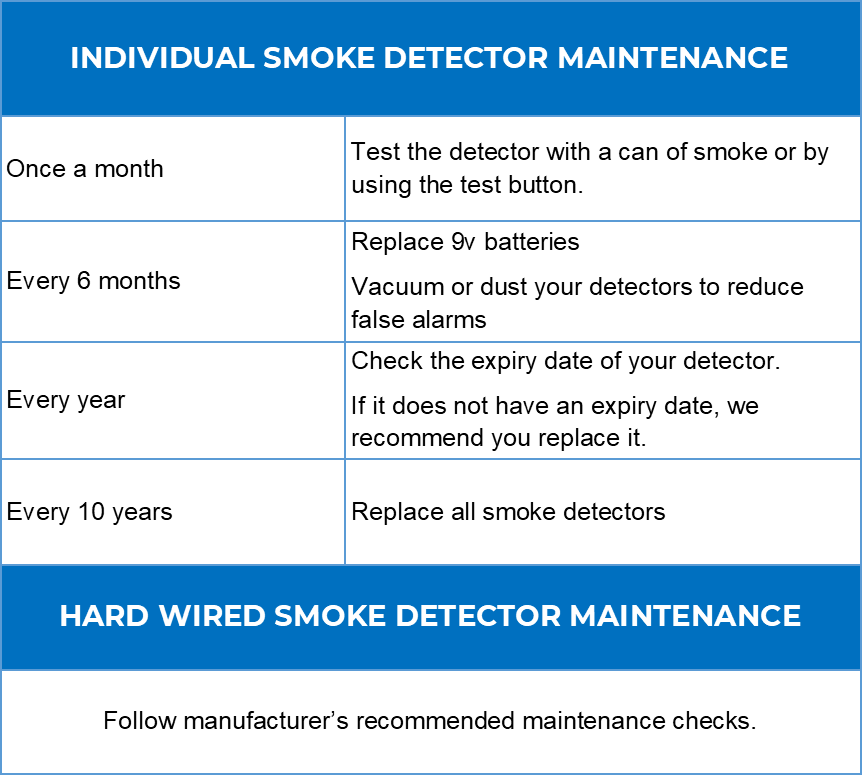Time to check your smoke alarms
Over 80% of fatal New Zealand house fires start through smoke alarm neglect, which is why it’s crucial that heat and smoke detectors are installed and regularly maintained. Smoke and heat detectors should be maintained on a six-monthly basis which is why we are often reminded to check them at the beginning and end of day light savings. Now, while we are all spending more time at home is a great time to make sure that you have the right detectors installed and that they are operating correctly.
Types of smoke alarms:
Smoke detectors, or smoke alarms, use either photoelectric or ionisation sensors to detect smoke.
Ionisation alarms
Ionisation alarms are most effective at detecting fast-flaming fires that burn and spread quickly. However, they can be prone to nuisance alarms from cooking and steam so shouldn’t be located near your kitchen or bathroom.
Ionisation smoke detectors use a small amount of radioactive material to ionize air in an internal chamber to allow a constant current that flows back and forth between two metal plates. Once smoke enters the chamber it mixes with the ionised air causing the current flow to stop which will sound the alarm
Photoelectric alarms
Photoelectric alarms are best at detecting slow smouldering fires, which can burn for hours before bursting into flame. Photoelectric alarms work in a similar way to ionisation alarms but instead of an electric current they use a beam of light. When smoke enters the chamber, some of the light is scattered and hits the sensor, triggering the alarm.
Dual sensor alarms
These contain both an ionisation sensor and a photoelectric sensor, so they provide the best and worst features of both types. They can be a good option, but as with any ionisation alarm, it’s not recommended to installed them near a kitchen or bathroom.
Other types of alarms:
Heat Detectors
Heat detectors sound an alert when a temperature increase is detected.
This type of detector is usually used in rooms that aren’t frequently occupied, as they take a little longer to detect a fire than a smoke detector, however the benefit they offer is that they have fewer false alarms as they do not react to steam, dust, humidity or precipitation.
Heat detectors are also a good option for kitchens, as they will not be set off when you accidentally burn your toast.
Carbon Monoxide alarms
Carbon monoxide is a waste product of gas heating so if you have a gas heating system it is worth installing a carbon monoxide alarm in case the heater develops a fault.
What type of smoke alarms should you install?
The NZ Fire Service recommends that you install hard wired and interconnected smoke alarms so that if one alarm is set off they will all sound an alert.
If you are unable to install hard wired alarms, they recommend the use of long-life photoelectric smoke alarms. These have an inbuilt long-life battery, so you don’t need to worry about replacing it (or it going off in the middle of the night when the battery runs low), you simply replace the whole unit every 10 years.
EAS can help you with installing smoke alarms in your home – both long-life and hard wired solutions. If you would like assistance with annual testing, we can help with that too. Just give us a call on 834 0505 or [email protected]
How many smoke alarms should I have?
The NZ Fire Service recommends that you install a smoke alarm in every bedroom, hallway and living area as smoke alarms cannot detect smoke through a closed door.
The NZ building code is slightly less stringent and requires an approved smoke alarm to be fitted in every escape route (hallway) and within 3m of a bedroom door.
The Residential Tenancy Act requires landlords install and replace expired smoke alarms with long-life battery photoelectric alarms.
Regular testing & maintenance:
Smoke alarms provide an important safety measure for your home or business but it is essential that you maintain them so they can provide you with piece of mind.
We recommend you check your ionisation smoke detectors monthly. This can be done by spraying a can of smoke, which can be purchased at the likes of Bunnings, near each detector head to ensure it is sensing the smoke and reacting as required. On your home alarms, there may be the option to instead use the test button to check the alarm.

If you would like help with installing or maintaining the smoke alarms in your home, get in touch with the EAS team today on 07 834 0505 or [email protected]

Leave a Reply
Want to join the discussion?Feel free to contribute!